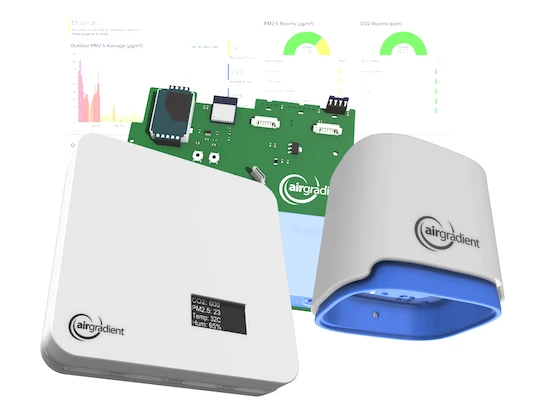Open and Accurate Air Quality Monitors
We design professional, accurate and long-lasting air quality monitors that are open-source and open-hardware so that you have full control on how you want to use the monitor.
Learn Moreby Achim Haug on February 27, 2021
Unlike with PM 2.5 where there are already quite established global standards, the standards and guidelines around CO2 are less known and well worth a more detailed look.
In the following, we want to look at different standards and guidelines from different countries and then come up with our own recommendation on what you could implement in your school’s policy.
This is a common standard for commercial buildings from the American Society of Heating, Refrigerating, and Air-Conditioning Engineers (ASHRAE) and often quoted in various studies. There is a good summary of the standard by Trane. For CO2 this standard recommends that indoor CO2 levels should not be higher than 700ppm compared to outside. If we assume around 400ppm outside, this would mean that ASHRAE recommends a maximum of 1100ppm for indoor CO2.
The European Standard EN13779 classifies CO2 into high, medium, moderate, and low quality based on the increase towards the outside CO2 level. If we assume again an outside CO2 level of 400ppm this standard would come to:
High Quality: <400ppm
Medium Quality: 400-600ppm
Moderate Quality: 600-1000ppm
Low Quality: >1000ppm
This guideline on ventilation, thermal comfort and indoor air quality in schools states that the average concentration of CO2 during the occupied period should not exceed 1500 ppm and maximum CO2 levels should not exceed 2000 ppm for more than 20 minutes.
This standard from the Netherlands defines a peak value of CO2 at 1200 ppm.
Some of the guiding principles in this study were:
This Swedish standard from 2007 defines maximum acceptable CO2 values in two air quality classes AQ1 and AQ2 as 800ppm and 1000ppm respectively. Besides the CO2, the Swedish standard also defines thermal climate, indoor air quality besides CO2, sound, and light.
This review of Australian and New Zealand Standards states that the standards of the respective countries are based to a large extent on the ASHRAE standard.
This review also states that according to the New Zealand NZS 4303 Standard, 1,000ppm should be the maximum CO2 exposure.
It can be seen that most of the standards are quite similar and align with the research of cognitive impacts by high CO2 values. According to this study cognitive impacts are already statistical significant at 950ppm and at values of 1400ppm pose a considerable impact.
Our recommended CO2 levels for Classrooms (in ppm)
400-600: Excellent
601-750: Good
750-1000: Moderate
1001-1500: Mediocre
1501-2500: Bad
2501-5000: Very Bad
For unventilated classrooms, especially if the windows are not frequently opened this can be challenging to achieve. However considering that the very purpose of a classroom is for our students to gain knowledge and insights, healthy CO2 levels are paramount and can have a significant impact on test scores.
If you have a fresh air system installed in your school, we recommend to set it to keep the CO2 at 800ppm or below. If you are dependent on manual ventilation, windows should all be opened in every break (or if the climate permits during the whole class) and the average exposure of the students should be less than 1000ppm throughout the school day.
Curious about upcoming webinars, company updates, and the latest air quality trends? Sign up for our weekly newsletter and get the inside scoop delivered straight to your inbox.
Join our Newsletter
We design professional, accurate and long-lasting air quality monitors that are open-source and open-hardware so that you have full control on how you want to use the monitor.
Learn More